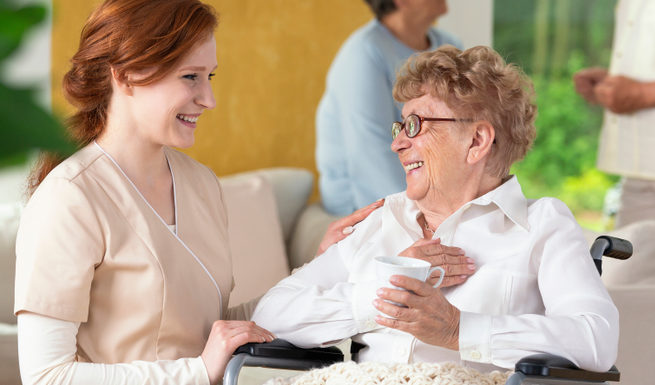The topic of safe patient/resident transfers and handling covers two very distinct groups and discussions which overlap and occasionally create a perception of conflict.
The conundrum within a healthcare or residential environment is how you facilitate safe, timely and dignified transfers for the individual whilst maintaining and maximizing carer safety. Pressure on time sometimes means that corners are cut on carer safety to facilitate speed whilst impacting on patient/residents dignity and involvement in the process.
When considering safe transfers health care professionals tend to focus on hoisting and those who are most vulnerable or in need. However, there is a wide range of transfers where safety is a consideration some of which can be overlooked due to their perceived low risk. Risk in these instances has likely been determined by the likelihood of litigation, both from personnel and patient/resident/family but not as part of a formalized manual handling risk assessment necessarily. For example, the perception may be that hoisting poses a greater risk than supporting an individual to stand from sitting whereas the latter poses a far greater risk of falls to the individual and is likely to be a task completed more frequently.

Interestingly, and indeed crucially the Nurse and Healthcare Worker Act (2015)[1] confirms that:
‘Registered nurses ranked sixth among all occupations for the number of cases of musculoskeletal disorders resulting in days away from work, with 11,360 total cases. Nursing assistants reported 20,020 cases in 2014, the second-highest of any profession. The leading cause of these health care employees’ injuries is patient lifting, transferring, and repositioning injuries, which constitute a significant risk to the health and welfare of those employees’
Within Section 2 of the conclusions, titled ‘Safe Patient Handling, Mobility & Injury Prevention Standards’ the legislation goes on to stipulate:
‘safe patient handling, mobility, and injury prevention standard shall require the use of engineering and safety controls to perform handling of patients and to reduce the incidence of injuries from manual handling of patients by direct-care registered nurses and all other health care workers, through the development of a comprehensive program, to include the use of mechanical technology and devices to the greatest degree feasible.’
How therefore do Health Care Professionals (HCP’s) use mechanical technology & devices to support safe transfers for themselves and the patient/resident? Indeed, do HCP’s know the market well enough to be able to advise legislators or state health Secretaries on which devices would support safety?
Range of transfers
Hoisting
Most HCP’s and healthcare assistants are familiar with hoisting equipment, particularly passive full-body hoists. It is critical to ensure that the person being hoisted is empowered within the hoisting process to take control of any elements of the task of which they are otherwise powerless to control. To maximize safety staff must be trained with the hoisting techniques and medical device being used as well as ensuring that handling plans are regularly reviewed and updated.
Sit to stand
Often when facilitating a standing transfer a change in seating is considered, particularly to raise height or to include a rising feature, therefore supporting the stand and reducing risk. However, in the circumstances where the resident wishes to continue using their current chair or indeed may adopt a more sedentary lifestyle in a reclining feature is in-built devices such as a raising cushion may be appropriate. These portable aids also allow for the user to stand safely more flexibly within their home or social environment.
Bed
Sitting up in bed or getting residents legs into bed can often put quite a strain on care providers, particularly when legs are oedematous. The ability to independently get legs into and out of bed, as well as sit up in bed also has a significant functional impact. Devices such as the Pillowlift or Leglifter can remove carer strain, reduce care packages and maximise functional independence/engagement.
For patients/residents with greater nursing needs devices such as turning systems allow carers to manage both skin integrity and moving and handling techniques independently or with reduced risk.
Bath
Bathing is something often overlooked from a transfer perspective but often constitutes one of the highest risk transfers whether being hoisted or facilitating independence due to the environment which is often inflexible and poorly designed. Products such as a bathing cushion or bath lift can reduce carer handling whilst maximizing safety and independence.
For those with greater needs, it is important to consider devices such as ceiling track hoist systems as well as height adjustable baths.
Falls
One of the most overlooked yet potentially complex transfers that is so often overlooked is supporting a person from the floor following a fall. Although risk assessments and subsequent actions may reduce risks of falls we must accept that promoting engagement in the activity and indeed activity itself is inherently risky. Indeed risk assessments should not inhibit but proactively promote ‘safe’ risk taking. Falls, therefore, are inevitable, particularly in the nursing environment.
A delayed initial recovery [1] poses the greatest risk to the faller, both medically and psychologically therefore access to the appropriate medical devices is crucial to support positive outcomes and maximize future activity engagement. Equipment such as the Mangar Elk and Camel allow caregivers to move the person from the floor with no physical lifting, maximising their recovery and removing the risk to the caregiver.
Ensuring that HCP’s, assistants and therefore health secretaries/budget holders/commissioners know the moving and handling medical device market is crucial to maximize safety, dignity and cost-effectiveness. Without this knowledge, a clinician’s clinical reasoning is limited within the constraints of a narrow evidence base which is unacceptable.
Advocate, support, empower, engage and motivate residents/patients/staff whilst at the same time reducing risk; they are not mutually exclusive.
[1] https://www.archives-pmr.org/article/S0003-9993(15)00378-0/fulltext
[1] https://www.congress.gov/bill/114th-congress/house-bill/4266/text?q=%7B%22search%22%3A%5B%22%5C%22hr4266%5C%22%22%5D%7D&resultIndex=1



